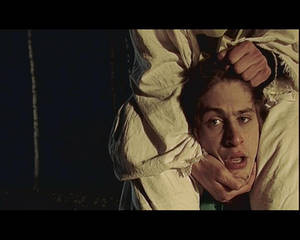Csaba Nemes
06 Jun - 31 Jul 2009
CSABA NEMES
"Every Day is 1956"
Opening and Gallerybreakfast of the 6th and 7th District of Vienna
Saturday 6th of June 2009, 10 a.m.
The exhibition lasts until 31st of July 2009
The tension coming from the recent political changes and its influence on everyday life can be seen in the latest works of Csaba Nemes, showing the complex relationship of public space and representation, roleplaying and media. The acts and beings of the characters of his video titled "Softies", are also based on romantic media cliches. But beside that one of them chooses the name of the main character out of the previously famous tv-series called "Tenkes kapitánya" (Captain of Tenkes), they wear costumes when carrying out their outlaw actions. Their "Heroic Act" is coming alive in the frame of an interview, where their general attitude can be detected. Their actions - although well-planned - are also incidental in the sense of missing an overall ideology behind them. They realize their happens by riskless roleplays, where they do not care about the consequences of these games. However, while they are mostly just posing for the camera, their roleplays have real victims. The players are not just documenting their acts for the public of the Internet, but also accomplishing and recording their "heroic" actions according to the "requirements" of this form of representation.
The subjects of Nemes's paintings are buildings and locations, that at the same time invoke social and political questions. His characters are everyday "heroes" of the public space: figures holding flags and other figures of the demonstrations, which are slowly becoming accustomed in Budapest since Autumn 2006. His painting-series, titled "Everyday '56" point out the interaction between public space and media space. The title is based on a graffiti, seen on buildings in Kazinczy street in Budapest, and which also appeared in other parts of the town. He depicts scenes in which the signs of "national" identity used on demonstrations are represented as everyday articles for personal use. But the very same symbols, which can be seen in the news and the printed media, due to the transmission of the media are becoming more and more popular among those who use the streets as a stage. This way they want to demonstrate their role in public space, and create by using their strange tools visionalistic, almost unprobable situations. Beyond the events refering to the here and now, the questions of the different levels of publicity and its interactions, Csaba Nemes is also interested in the socialist past. With his interest for spaces which in those times were closed for the public, he recalls events and places also important on the level of collective memory today.
Translated by Judit Galácz and Krisztina Hunya
"Every Day is 1956"
Opening and Gallerybreakfast of the 6th and 7th District of Vienna
Saturday 6th of June 2009, 10 a.m.
The exhibition lasts until 31st of July 2009
The tension coming from the recent political changes and its influence on everyday life can be seen in the latest works of Csaba Nemes, showing the complex relationship of public space and representation, roleplaying and media. The acts and beings of the characters of his video titled "Softies", are also based on romantic media cliches. But beside that one of them chooses the name of the main character out of the previously famous tv-series called "Tenkes kapitánya" (Captain of Tenkes), they wear costumes when carrying out their outlaw actions. Their "Heroic Act" is coming alive in the frame of an interview, where their general attitude can be detected. Their actions - although well-planned - are also incidental in the sense of missing an overall ideology behind them. They realize their happens by riskless roleplays, where they do not care about the consequences of these games. However, while they are mostly just posing for the camera, their roleplays have real victims. The players are not just documenting their acts for the public of the Internet, but also accomplishing and recording their "heroic" actions according to the "requirements" of this form of representation.
The subjects of Nemes's paintings are buildings and locations, that at the same time invoke social and political questions. His characters are everyday "heroes" of the public space: figures holding flags and other figures of the demonstrations, which are slowly becoming accustomed in Budapest since Autumn 2006. His painting-series, titled "Everyday '56" point out the interaction between public space and media space. The title is based on a graffiti, seen on buildings in Kazinczy street in Budapest, and which also appeared in other parts of the town. He depicts scenes in which the signs of "national" identity used on demonstrations are represented as everyday articles for personal use. But the very same symbols, which can be seen in the news and the printed media, due to the transmission of the media are becoming more and more popular among those who use the streets as a stage. This way they want to demonstrate their role in public space, and create by using their strange tools visionalistic, almost unprobable situations. Beyond the events refering to the here and now, the questions of the different levels of publicity and its interactions, Csaba Nemes is also interested in the socialist past. With his interest for spaces which in those times were closed for the public, he recalls events and places also important on the level of collective memory today.
Translated by Judit Galácz and Krisztina Hunya

